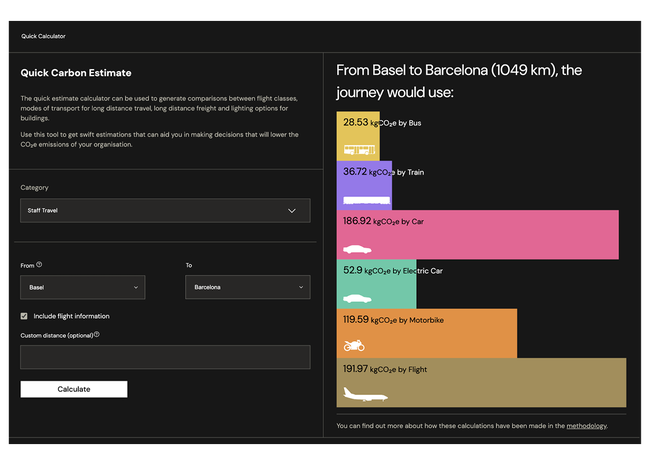Measure the carbon emissions of your art organisation or project
Get started

The GCC Carbon Calculator is a free online tool for estimating the greenhouse gas emissions of art organisations and projects.
Using common art world metrics, it provides a breakdown of emissions and offers both detailed reporting and a quick assessment tool to help manage your environmental impacts effectively.
For more detailed reporting, the GCC Carbon Calculator provides comprehensive insights, while the Quick Calculator offers a rapid assessment of your carbon footprint, ideal for preliminary evaluations or quick insights. Both elements are designed to help you understand and manage your environmental impact effectively.
Quick Calculator
The Quick Calculator tool has been designed to provide a rapid assessment for high-impact actions, such as air travel and long-distance freight, which can help to inform decision-making.

How It Works
GCC has identified three primary sources of carbon emissions common to galleries, institutions, artist studios, and businesses in the art sector: travel, shipping and building energy consumption.
- These are key data points that we encourage users to prioritise when creating a carbon report.
- The calculator also provides additional data categories to give users a full picture of their emissions across categories including surface travel, accommodation, materials and digital.
- Users are given a full breakdown of their carbon emissions, with visuals, at the end of the report to reflect on and proactively make changes within their organisations.
- Completing an annual carbon report will allow users to gain a GCC active membership status. You can learn more about active membership here.
Priority Data
-
Air travel
This will allow you to calculate your emissions based on flight type (one-way or return), where you flew from and to, the class you travelled in, and the number of people on the trip. -
Shipping
This will give you insight into emissions from transporting artworks and other items, including both long-distance and local freight. You can enter data for road, ocean, and air freight. -
Energy
Here, you can estimate your building energy usage and calculate emissions from varying energy types. You can also add details about refrigerant chemicals and offsite storage.
Additional Data
-
Surface travel
Record how you and your team get around on land, via business vehicle use, public transport, taxi or ferry. -
Accomodation
Enter details about where you've stayed to understand the emissions associated with your accommodation choices. -
Materials
Keep track of what you use for your projects. This category will give you insight into emissions from purchased materials used for artworks, exhibitions, packaging, events, and office supplies. -
Digital
This gives you an estimate of emissions from websites, video calls, basic cloud storage, and emails.